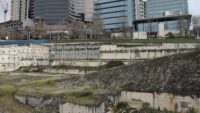More than any other European nation, the U.K. is pinning its hopes for a low-carbon-electricity future on offshore wind power. It already has more offshore generation than any other nation, at over 1,000 MW. But with construction costs posing the major hurdle to reach the U.K.’s goal of generating 12,000 MW by 2020, the quest is on for the best foundations in ever-deeper waters.
Because of supply bottlenecks and other factors, the real construction cost of offshore wind farms has risen 20% since the first commercial schemes were built seven years ago, says Rob Hastings, head of marine resources at the Crown Estate, London. The U.K. federal agency controls seabed exploitation of the nation’s continental shelf. At current costs, the technology is “at the edge of viability,” Hastings adds.
The price is making it difficult to reach the goal of 12,000 MW by 2020, which, in any case, “represents a poverty of ambition,” says Maria MaCaffery, chief executive of the trade association RenewableUK. For the U.K. industry to become viable and an exporter, 20,000 MW is needed by 2020, she claims.
With even the lower target requiring a $60-billion-plus investment, funding is “the most significant barrier,” says a recent report, “Meeting the 2020 Renewable Energy Targets: Filling the Offshore-Wind Financing Gap,” by consultant PricewaterhouseCoopers, London.
New sources of financing must be found, agrees Andrew Buglass, head of power, structured finance, at Royal Bank of Scotland plc., Edinburgh. “There has to be a step change” in investment, he says.
By the middle of this year, nearly 2,500 MW of offshore plants were in operation in European water, 40% of them in the U.K., according to RenwableUK. Another 4,000 MW was in construction or had secured planning consent in the U.K. alone.
Development rights to roughly 35,000 MW of wind power in nine U.K. sites were awarded this January. With all of these and other plans, some 50,000 MW of offshore wind projects are in development, construction or operation around the U.K., says Hastings.
Even to reach the official target for generation capacity, the rate of construction must rise from approximately one turbine installation every 11 days currently to 2.5 per day by 2020, says Michael Rea, chief operating officer of Carbon Trust (CT), the government’s not-for-profit company promoting low-carbon development. With foundation structures and installation accounting for 20% to 30% of the capital cost, CT is investing around $30 million to find more economical designs.
Following its international launch of an ideas competition last year, CT has spotted 15% to 20% in potential cost savings, says Phil de Villiers, manager of CT’s $47-million offshore accelerator program. The effort, funded by five large energy companies, is intended to speed up development.
From more than 100 competition submissions, CT short-listed and funded four designs for further development as demonstration projects. The intention is to start construction of the first one next year. The key will be “mass production [and] faster, cheaper installation,” says de Villiers.
In shallow waters exploited to date, developers have used a monopile to support a turbine and tower. These typically 4-meter to 5-m-dia single steel tubes are driven into the seabed and rise to just above the water level. A steel tube “transition piece” is slotted over the monopile and grouted to it. The transition piece’s top, standing some 20 m above the water, forms a platform for the tower and turbine.
Monopiles have suited near-shore sites in water depths typically under 30 m. But as developers exploit more remote waters up to 80 m deep, “we need to move away from monopiles,” says de Villiers.
Of the designs on CT’s short list, only one uses a monopile: The Danish MBD Offshore proposal incorporates a skirted base from which air would be sucked to help the pile penetrate the soil.
A rival design by Glosten Associates Inc., Seattle, uses a tethered floating foundation. Another U.S. scheme, by Keystone Engineering Inc., Houston, is based...







Post a comment to this article
Report Abusive Comment